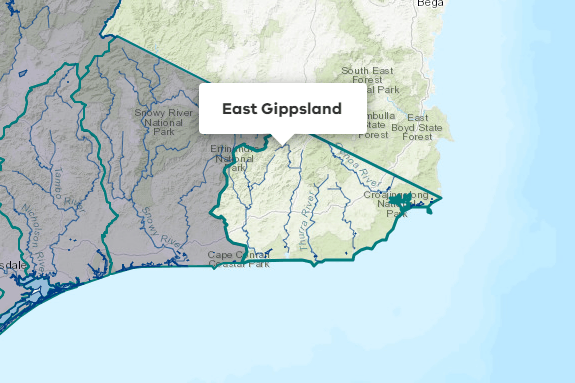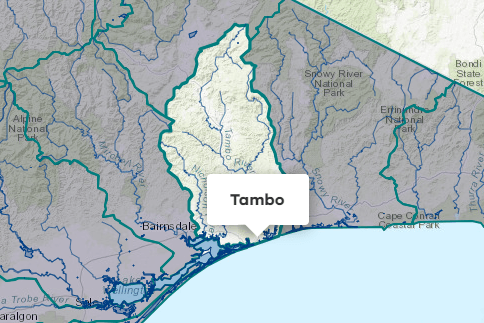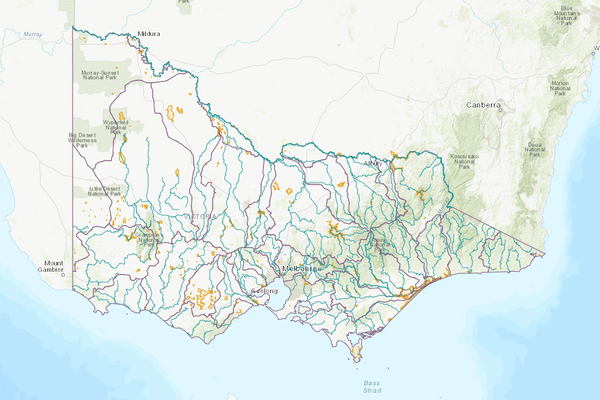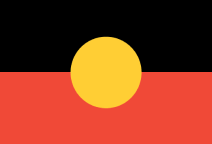About the area
Victorias Snowy basin is in East Gippsland. The Snowy River originates in New South Wales (NSW) and is part of the Snowy Mountains Hydro-Electric Scheme, which connects it to the Murray and Murrumbidgee rivers.
Much of the mountainous Snowy basin is covered by National Parks; it is largely forested aside from some localised areas of farmland.
Most of the basin has an annual rainfall of 600 - 900 mm, with wetter areas in the east and north-west receiving 900-1200 mm, in the upper reaches of the Snowy, Deddick and Brodribb Rivers.
As these Accounts provide a record of water availability and use across Victoria, they only consider the portion of the Snowy basin located in Victoria.
More information on water management and accounting is detailed in Water explained.
2022-23 overview
Available water
Catchment inflow was lower than the previous year.
Licensed diversion restrictions
There were no restrictions on licensed diversions, the same as the previous year.
Water use
Slightly more water was diverted for consumptive purposes as the previous year.
When compared to the previous year, in 2022-23:
- less rainfall was received and catchment inflow was lower
- licensed diversion restrictions were the same with no restrictions on licensed diversions from unregulated streams
- slightly more water was diverted from the basin for consumptive uses.
Climate
2022 Flooding
In October 2022, a series of low-pressure systems or surface troughs travelled over south-east Australia, bringing heavy rainfall and storms. The cumulative impact of these on catchments and waterways led to widespread flooding in several basins. Major flooding of the Snowy River led to impacts on towns including Orbost.
Rainfall
In 2022-23, less rainfall was received in the Snowy basin than the previous year. Rainfall was:
- very much above the long-term average in the northern headwaters of the Buchan and Suggan Buggan rivers
- above average in the northern third of the basin
- average over the remaining central and coastal regions.
Figure 1 displays the rainfall received in 2022-23 compared to the long-term average (1975-2023).
Figure 1: Rainfall deciles, Snowy basin
Sourced from the Australian Bureau of Meteorology
River basin water balance
This section describes the known and estimated inflows, outflows and change of storage volumes in the basin.
Consumptive use in the basin is generally very low compared to water availability, and almost 100% of total inflows passed to Bass Strait in 2022-23.
Water balance table
The table below shows the total volumes of water available and supplied from water resources in the Snowy basin in 2022-23.
Table 1: Water balance, Snowy basin
Inflows
Catchment inflow
Catchment inflow represents the volume of water flowing into the waterways of a basin. It is calculated as the total outflows and change in storage minus the known inflows.
Victorian catchment inflows into the Snowy basin in 2022-23 were 2,412,223 ML, or 303% of the long-term average. This was less than the record-breaking inflows in the previous year (3,820,977 ML or 480% of the long-term average).
Above average inflow received
Catchment inflow was 303% of the long-term average.
Less water received than last year
Catchment inflow was lower than the previous year (480% of the long-term average).
Wastewater treatment plants
Water treated at wastewater treatment plants can be used to supplement water available in the basin. Water discharged to waterways from treatment plants is included as an inflow to the water balance.
Information on treatment plants is reported in the water supply local reports for the water corporation responsible for managing the plant.
In this basin, wastewater treatment plants are managed by East Gippsland Water.
Outflows
Diversions
In 2022-23, 2,944 ML of water was diverted for consumptive uses: town, domestic and stock, irrigation, and commercial supply. This was slightly more than the 2,721 ML diverted in the previous year.
Small catchment dams
Water harvested, used, and lost by small catchment dams (farm dams) is included in the water balance.
Table 2: Small catchment dams, Snowy basin
Entitlements and compliance
Entitlements provide the basis for how water is shared in the basin.
Entitlement volumes
Rights to water in the Snowy basin are shown in Table 3.
Entitlement volumes represent a maximum volume of water that can be taken in a one-year period. The volume available in a particular year is dependent on the rules for allocating water set out in the entitlement and the seasonal conditions in that year, which can vary. The rules for allocating water under an entitlement differ between entitlements and systems. This affects the ability and likelihood of water being taken in a particular year.
In the New South Wales portion of the Snowy basin, Snowy Hydro Limited releases water under a licence issued by that states Department of Planning, Industry and Environment.
Table 3: Annual entitlement volumes at 30 June, Snowy basin
Available water and take under entitlements
Total water available under entitlements represents the volume of water that was available to be taken by entitlement holders in 2022-23. The volume includes seasonal allocations and net trade into the basin.
Water taken
There was 1,901 ML taken under entitlements in 2022-23, more than the previous year (1,539 ML).
Restrictions on licensed diversions from unregulated rivers
There were no restrictions on licensed diversions from unregulated streams in 2022-23, the same as during the previous year.
Available water and take table
This table shows the volume of available water and the volume taken under entitlements in 2022-23.
More information on available water and take has been detailed in How we account for surface
In 2022-23, more water was taken under entitlements than the previous year.
Table 4: Available water and take under entitlements, Snowy basin
Compliance
Compliance against water entitlements is reported for this basin in 3 areas:
- entitlement issued: that the volume of entitlements issued in a basin does not exceed formal caps, and has not increased without appropriate approvals
- water taken: that the volume of water taken during the year does not exceed the volume considered to be available for consumptive and/or in-stream use during that year
- bulk entitlement provisions: that holders of entitlements do not breach any provisions that are documented in their bulk entitlement orders.
Total entitlement volume
There was no net increase in the total entitlement volume from the previous year.
Total volume diverted
The total volume diverted under entitlements (1,901 ML) was within the volume available for the year (7,712 ML).
Individual bulk entitlements
No individual bulk entitlement holder took more than the annual volume made available to them.
Exceptions to compliance
Individual bulk entitlement holders complied with all provisions in their entitlements.
Water for the environment
Environmental watering sites
Environmental watering sites and environmental values in the Snowy basin that depend on water for the environment include:
- Australian grayling populations, heritage river reaches, the Ewings Marsh wetlands complex and the Snowy River daisy
- freshwater species (such as river blackfish and Australian grayling) found in the upper reaches and tributaries of the Snowy River
- the lower reaches of the Snowy River, which support species including estuary perch and Australian bass that move between saltwater and freshwater systems
- estuarine and saltwater species (such as flathead, mulloway and black bream) in the estuary
- the nationally important floodplain wetlands of the Snowy River near Marlo, which provide feeding and breeding areas for wetland and migratory birds.
The NSW Department of Planning, Industry and Environment (DPIE) manages environmental flows for the Snowy River. In the New South Wales portion of the Snowy basin, Snowy Hydro Limited releases water under a licence issued by DPIE for environmental benefit. More information on environmental flows in the Snowy basin is provided in Managed environmental water.
Environmental water reserve
In 2022-23, water for the environment in the Snowy basin comprised:
- water set aside for the environment through the operation of passing flow conditions:
- on the water licence issued to Snowy Hydro
- on consumptive bulk entitlements held by East Gippsland Water
- on licensed diversions
- water recovered for the environment as part of the Snowy Water Inquiry and released by Snowy Hydro in accordance with conditions of its water licence
- all other water in the basin not allocated for consumptive uses: this water also provides social, recreational and cultural benefits.
Environmental water use
A total of 203,500 ML of environmental water was delivered from the Snowy Mountains Hydro-Electric Scheme to the Snowy River between 1 May 2022 and 30 April 2023, which was the 2022-23 water year as defined under the Snowy Water Licence. This water was released downstream of Jindabyne Dam and Mowamba Weir in New South Wales, and it included 9,000 ML of passing flows and 194,500 ML of water recovered as part of the Snowy Water Initiative. More information is detailed under the Snowy Water Initiative.
Management responsibilities
Management of water in the Snowy basin is undertaken by various parties
| Authority | Management responsibilities |
|---|---|
| Southern Rural Water |
|
| East Gippsland Water |
|
| East Gippsland Catchment Management Authority |
|
| Snowy Hydro Limited |
|
| Water supply system | 2021-22 (ML) | 2022-23 (ML) |
|---|---|---|
| Buchan | 15 | 21 |
| Orbost System | 589 | 778 |






